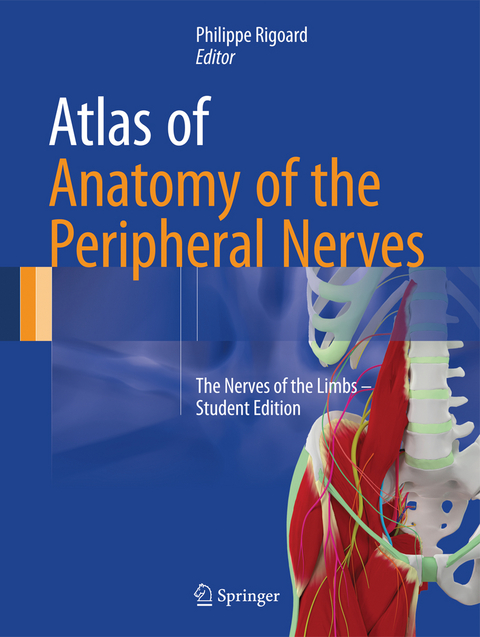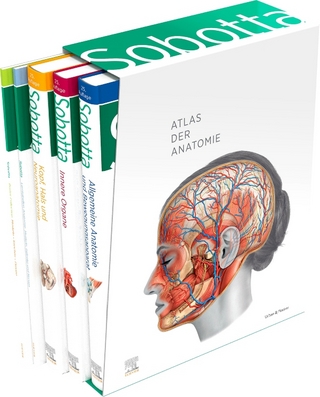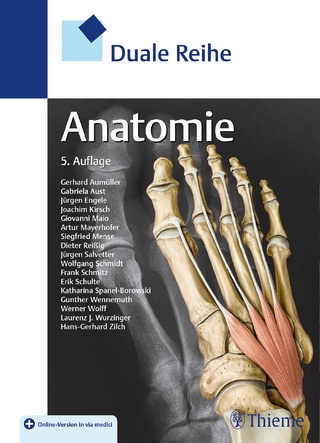
Atlas of Anatomy of the Peripheral Nerves
Springer International Publishing (Verlag)
978-3-319-43088-1 (ISBN)
This atlas also features 261 outstanding full-colour 2D and 3D illustrations. Each picture has been designed in 2D and 3D with a combination of the original editor’s personal drawings/paintings and 3D-modeling tools. This book is a valuable resource for anyone studying medicine, anaesthesiology, neurosurgery, spine surgery, pain, radiology or rheumatology and is also of high interest to the whole medical community in general.
Prof. Philippe Rigoard is a Senior surgeon and coordinator of the Spine & Neuromodulation Unit within the Neurosurgical Department, at the Poitiers University Hospital, in France. He is also an Honorary Consultant at St Thomas & Guy’s Hospital, Pain clinic, in London, UK, an Anatomy conference reader at the Human Morphology Institute, Faculty of Medicine of the University of Poitiers and a Researcher at the Inserm, CIC (Clinical Investigation Center) 802. He is research program director of the N3Lab, Neuromodulation & Neural Networks Lab in Poitiers. In parallel of studying anatomy and morphology at National Art Institute, Beaux-Arts, Paris, from 1994-1996, he decided to enter into medicine. He received his medical degree as 1st Laureate of faculty of Medicine, Poitiers in 2006 and completed postgraduate medical training in spine surgery 2008 and a fellowship in functional neurosurgery in 2009. From 2002-2007 he also completed his PhD of Sciences, in Poitiers as well as several degrees including in Neuromuscular Diseases, acute pain, chronic pain and pain management in emergency conditions, microsurgical techniques and surgical robotics.His main research interest is neuromodulation and spine biomechanics. He has intensive scientific collaborations with several researchers worldwide, e.g., Dr. Kumar (Canada), Dr. Desai, Dr. North, Dr. Slavin (USA) and Dr. Al-Kaisy (UK). He is reviewer for many scientific journals and a member of several learnt societies, including the International Association for the Study of Pain, International Neuromodulation society, European Association of Neurosurgeons, French and North American Society of Spine Surgery. He has also published dozens of journal articles, abstracts, and book chapters, and has lectured at numerous conferences and symposia worldwide.
LIST OF CONTRIBUTORS
FOREWORD
ACKNOWLEDGEMENTS
ANATOMY PREAMBLE
ABOUT THIS BOOK
CONTENTS
Part I : Morphological and functional anatomy of the peripheral nerve
1. The normal nerve
1.1. General organisation of the peripheral nerve
1.2. The nerve’s structure and physiology
1.3. Schwann cell and myelinisation
1.4. Mechanical properties of the nerves
1.5. Vascularization of the peripheral nerve
1.6. Neuromuscular junction and transmission
1.7. Main mechanisms of synaptic formation
2. The injured nerve
2.1. Physiology of the damaged nerve
2.2. Nerve degeneration
2.3. Mechanisms of neuronal reparation
3. The Plexus
3.1. Data issued from embryology
3.2. Development of the innervation of limbs
3.3. Innervation of the limbs in adults
3.4. The notion of plexus
Part II: Nerves of the upper limb
1. The brachial plexus
1.1. Morphological data
1.2. The brachial plexus' relations
1.2.1 At the supraclavicular level
1.2.2 At the infraclavicular level
2. The axillary nerve
2.1. Morphological data
2.1.1 Origin
2.1.2 Path
2.1.3 Neurovascular relation
2.1.4 Collateral branches
2.1.5 Terminal branches
2.1.6 Motor function
2.1.7 Sensitive function
2.1.8 Anastomoses
2.2. Pathology
2.2.1 Etiology
2.2.2 Clinical significance
2.2.3 Clinical forms
2.2.4 Complementary examinations
2.2.5 Treatment
3. The musculocutaneous nerve
3.1. Morphological data
3.1.1 Origin
3.1.2 Path
3.1.3 Neurovascular relation
3.1.4 Collateral branches
3.1.5 Terminal branches
3.1.6 Motor function
3.1.7 Sensitive function
3.1.8 Anastomoses
3.2 Pathology
3.2.1 Etiology
3.2.2 Clinical significance
3.2.3 Clinical forms
3.2.4 Complementary examinations
3.2.5 Treatment
4 The radial nerve
4.1 Morphological data
4.1.1 Origin
4.1.2 Path
4.1.3 Neurovascular relation
4.1.4 Collateral branches
4.1.5 Terminal branches
4.1.6 Motor function
4.1.7 Sensitive function
4.1.8 Anastomoses
4.2 Pathology
4.2.1 Posterior interosseous nerve syndrome
4.2.2 Etiology
4.2.3 Clinical signs
4.2.4 Clinical forms
4.2.5 Complementary examinations
4.2.6 Treatment
5 The median nerve
5.1 Morphological data
5.1.1 Origin
5.1.2 Path
5.1.3 Neurovascular relation
5.1.4 Collateral branches
5.1.5 Terminal branches
5.1.6 Motor function
5.1.7 Sensitive function
5.1.8 Anastomoses
5.2 Pathology
5.2.1 Anterior interosseous nerve syndrome
5.2.2 Etiology
5.2.3 Clinical significance
5.2.4 Clinical forms
5.2.5 Complementary examinations
5.2.6 Treatment
5.3 Carpal tunnel syndrome
5.3.1 Clinical signs
5.3.2 Differential diagnosis
5.3.3 Treatment
6 The ulnar nerve
6.1 Morphological data
6.1.1 Origin
6.1.2 Path
6.1.3 Neurovascular relations
6.1.4 Collateral branches
6.1.5 Terminal branches
6.1.6 Motor function
6.1.7 Sensitive function
6.1.8 Anastomoses
6.2 Pathology
6.2.1 Cubital tunnel syndrome
6.2.2 Etiology
6.2.3 Clinical significance
6.2.4 Clinical forms
6.2.5 Complementary examinations
6.2.6 Treatment
6.3 Ulnar tunnel syndrome (Guyon’s canal)
6.3.1 Etiology
6.3.2 Clinical signs
6.3.3 Clinical forms
6.3.4 Complementary examinations
6.3.5 Treatment
7 The suprascapular nerve
7.1 Morphological data
7.1.1 Origin
7.1.2 Path
7.1.3 Neurovascular relations
7.1.4 Collateral branches
7.1.5 Terminal branches
7.1.6 Motor function
7.2 Pathologies
7.2.1 Etiology
7.2.2 Clinical significance
7.2.3 Complementary examinations
7.2.4 Treatment
8 The long thoracic nerve
8.1 Morphological data
8.1.1 Origin
8.1.2 Path
8.1.3 Neurovascular relations
8.1.4 Terminal branches
8.1.5 Motor function
8.2 Pathologies
8.2.1 Etiology
8.2.2 Clinical significance
8.2.3 Treatment
9 Bibliography
Part III: Nerves of the lower limb
1. The lumbosacral plexus
1.1. Morphological data
1.1.1. The lumbar plexus
1.2. Morphological data
1.2.1. The sacral plexus
1.3. Relationship between the lumbar and sacral plexuses
1.4. Overview diagrams of the lower limb plexuses
2. The obturator nerve
2.1. Morphological data
2.1.1. Origin
2.1.2. Path
2.1.3. Neurovascular relations
2.1.4. Collateral branches
2.1.5. Terminal branches
2.1.6. Motor function
2.1.7. Sensitive function
2.1.8. Anastomoses
2.2. Pathology
2.2.1. Obturator neuralgia
2.2.2. Etiology
2.2.3. Clinical significance
2.2.4. Complementary examinations
2.2.5. Treatment
3. The femoral nerve
3.1. Morphological data
3.1.1. Origin
3.1.2. Path
3.1.3. Neurovascular relations
3.1.4. Collateral branches
3.1.5. Terminal branches
3.1.6. Motor function
3.1.7. Sensitive function
3.1.8. Anastomoses
3.2. Pathology
3.2.1. Femoral nerve syndrome or Femoral Neuralgia
3.2.2. Etiology
3.2.3. Clinical significance
3.2.4. Complementary examinations
3.2.5. Treatment
4. The sciatic nerve
4.1. Morphological data
4.1.1. Origin
4.1.2. Path
4.1.3. Neurovascular relations
4.1.4. Collateral branches
4.1.5. Terminal branches
4.1.6. Motor function
4.1.7. Sensitive function
4.1.8. Anastomoses
4.2. Pathology
4.2.1. Etiology
4.2.2. Clinical significance
4.2.3. Clinical forms
4.2.4. Complementary examinations
4.2.5. Treatment
5. The tibial nerve
5.1. Morphological data
5.1.1. Origin
5.1.2. Path
5.1.3. Neurovascular relations
5.1.4. Collateral branches
5.1.5. Terminal branches
5.1.6. Motor function
5.1.7. Sensitive function
5.1.8. Anastomoses
5.2. Pathology
5.2.1. Soleus syndrome
5.2.2. Etiology
5.2.3. Clinical significance
5.2.4. Complementary examinations
5.2.5. Treatment
5.3. Tarsal tunnel syndrome
5.3.1. Etiology
5.3.2. Clinical significance
5.3.3. Clinical forms
5.3.4. Complementary examinations
5.3.5. Treatment
6. The common fibular nerve
6.1. Morphological data
6.1.1. Origin
6.1.2. Path
6.1.3. Neurovascular relations
6.1.4. Collateral branches
6.1.5. Terminal branches
6.1.6. Motor function
6.1.7. Sensitive function
6.1.8. Anastomoses
6.2. Pathology
6.2.1. Fibular nerve injury
6.2.2. Etiology
6.2.3. Clinical significance
6.2.4. Clinical forms
6.2.5. Complementary examinations
6.2.6. Treatment
7. The lateral femoral cutaneous nerve
7.1. Morphological data
7.1.1. Origin
7.1.2. Path
7.1.3. Neurovascular relations
7.1.4. Terminal branches
7.1.5. Sensitive function
7.2. Pathology
7.2.1. Meralgia paraesthetica
7.2.2. Etiology
7.2.3. Clinical significance
8. Other nerves
8.1. Iliohypogastric nerve
8.1.1 Morphological data
8.2. Ilioinguinal nerve
8.2.1 Morphological data
8.3. Pathology
8.3.1 Entrapment neuropathies of the ilioinguinal nerve and of the hypogastric nerve
8.3.2 Etiology
8.3.3 Clinical significance
8.3.4 Clinical forms
8.3.5 Treatment
9. General views
10. Bibliography
INDEX
| Erscheinungsdatum | 13.10.2017 |
|---|---|
| Zusatzinfo | XXVIII, 322 p. 237 illus., 235 illus. in color. |
| Verlagsort | Cham |
| Sprache | englisch |
| Original-Titel | Atlas d'anatomie des membres - Nerfs peripheriques |
| Maße | 210 x 279 mm |
| Themenwelt | Studium ► 1. Studienabschnitt (Vorklinik) ► Anatomie / Neuroanatomie |
| Schlagworte | 3D • anatomy • Anesthesiology • Medicine • Minimally Invasive Surgery • Morpho-functional anatomy • Neuromuscular transmission • neurosurgery • Orthopedics • Pain Medicine • Peripheral Nerve • Plexus • rheumatology |
| ISBN-10 | 3-319-43088-2 / 3319430882 |
| ISBN-13 | 978-3-319-43088-1 / 9783319430881 |
| Zustand | Neuware |
| Haben Sie eine Frage zum Produkt? |
aus dem Bereich


